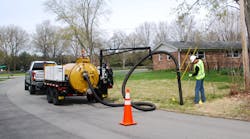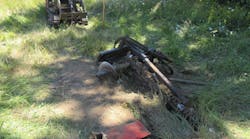Picturing children at play on the grass during elementary school recess is a familiar scene or memory for most of us. So now just try and imagine a play- ground without grass, and nowhere for children to safely play their favorite game of red rover or tag.
School systems in some parts of the country are finding it hard to grow turf grass for athletic fields and playgrounds, especially in a drought. Residents of Clark County, Nevada, fully understand the effects of drought. In fact, the Southern Nevada Water Authority pays its customers to remove grass from their yards because of the ongoing drought impacting the Colorado River and Lake Mead area. They believe that by removing all turf grass, they'll save water.
According to Joe Fortier, civil and landscape quality assurance construction inspector/manager for the Clark County School District in Las Vegas, schools need grass for kids to play on. "High schools and middle schools have fields for sports, however, elementary schools need to provide children with grass for outside activities," But, he adds, "We have greatly minimized the amount of turf that kids get to play on compared to what it was 15 or 20 years ago."
Drip Irrigation Systems Minimize Ground DisturbanceIn order to prompt the growth of turf grass on elementary school play areas, Fortier considered installing a drip irrigation system. After hearing of a system installed in Arizona, he became curious about how the same Netafim system would work in the tough Las Vegas soil conditions.
While installation of traditional drip irrigation systems involves trenching or plowing in one irrigation line at a time, a new attachment has provided contractors with a solution that helps to maximize job efficiency in various ground conditions while limiting jobsite reclamation and repair.
The Vermeer LM42 lawn plow with a multi-plow-blade attachment can pull up to three irrigation lines simultaneously at a predetermined depth and spacing determined by soil conditions. The plow-blade attachment uses a high-frequency vibration to cut through the ground and close up the channel around the dripper line. The unit is equipped with three reels that can each hold up to 1,000 feet of tubing which spins through a feed chute and is dispersed into the ground. It has the capability to lay three rows of tubing at a time, with depth adjustability from 2 inches to 12 inches in 1-inch increments and spacing width adjustability from 10 inches to 24 inches in 2-inch increments. A packer wheel maintains depths and recovers the trench after placing the product in the ground.
Drip irrigation systems distribute water and nutrients to the soil directly at the root zone, providing more efficient use of water resources. Applying water at a specific rate helps conserve water, and it helps turf mature in significantly less time.
Despite the water pressure, drip irrigation delivers a measured amount of water into the soil radiating out of drippers placed 12 inches or 18 inches apart inside the polyethylene pipe. The soil catches drops of water and radiates them outward, upward and downward from the dripper hole.
"I have used Netafim products in the past and was interested in the new method of installing drip irrigation into the ground," Fortier says. "With a school district of over 360 sites, including schools and administration buildings, I wanted to try something that would complement both elementary and high schools. In the future I'd like to use the system on high school football fields."
According to Fortier, providing a 30-foot buffer area around the perimeter of the fields would help avoid overspray on the synthetic tracks that is common to such fields, reducing salt damage to the tracks and water run-off.
To test the new blade attachment, Fortier chose the grounds of C.H. Decker Elementary School, a school located on the west side of Las Vegas that had an older irrigation system that was prone to water runoff. The irrigation system was tested on the school turf, which was comprised of dry and rocky soil through the 6-inch depth they were installing the tubing. "We picked this particular site because of its size and ground conditions. I wanted to start off with a smaller area to see how the system would work pulling turf grass in hard soil conditions," he says.
Approximately 2,200 feet of tubing was installed at the site in only an hour and half, compared to the several hours required with previous irrigation methods. The area where the pipe was installed measured approximately 100 feet long by 23 feet wide.
Fortier says he was surprised at how well the lawn plow and blade attachment performed in the rocky soil. "There was very minimal ground disturbance compared to other larger irrigation systems that I've used in the past. We've also saved a considerable amount of water, with minimal run-off into the streets," he says.
Other area contractors were present when the tubing was installed at the school, and many were impressed by how easy the installation process was.
"Overall, the project was a success, and I would use the system again," Fortier says. "This system promotes healthy turf growth, and gives children the opportunity to play their favorite games in the grass, rather than in gravel."




